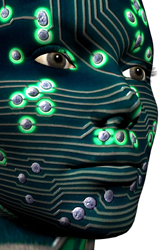Electronic control of molecule sized sensors
Combining knowledge and experience from a multitude of diverse scientific fields along with innovation and ingenuity has made the development of a minute bio-sensor a reality. The EU-funded SPOT-NOSED project has manufactured a nano-biosensor array. The scientists have anchored a single olfactory receptor between two metallic nano-electrodes. Changes of the electrical properties of the receptor are recorded and constitute the detection signal. This resulting nano-transducer is the basic component of the bio sensor array. To implement their ideas, SPOT-NOSED project partners used nano-lithography and microelectronics for the metallic electrodes, and biochemistry and biotechnology for isolating and controlling a sufficient number of olfactory receptors. An olfactory receptor, the sensor's detection system, selectively detects and distinguishes odour molecules. The single protein nano-biosensor grid array can perform electrochemical characterisation of many different samples with the aid of electronic instrumentation developed specifically for the array. Other commercially available electronic systems not only cost more but, more importantly, fail to drive and control the nano-transducers of the array properly. In contrast, the measuring system developed by the SPOT-NOSED project partners, easily adapts to electrodes ranging from micro- to nano-sizes. The nano-chip, with the aid of a board, fits perfectly into the electrochemical cell. Two different electronic front ends have also been developed for the micro and nano range of electrodes respectively. In the micro case, the front end draws 1µA maximum current with a 2MHz signal bandwidth. Corresponding values for the nano range are reduced to 10nA maximum current and 0.9MHz signal bandwidth. With elaborate software codes, effective generation and acquisition of signals resulting in efficient data handling is easily achieved.



